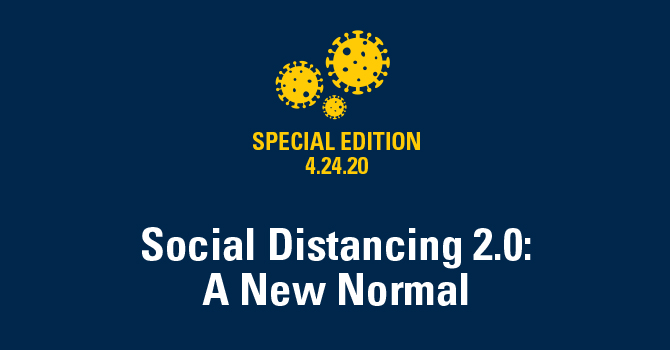Social Distancing 2.0: A New Normal

We are all getting antsy, wondering when we can return to work, see our friends and family in person, and get back to some sense of normal. Meanwhile, we might notice a planned temporary hospital wasn’t built or that some data on the local news seems to show a reduction in the spread of coronavirus. What are we supposed to do with these emerging shades of gray in a situation that felt so black and white not too long ago? In this episode, Abram Wagner, research assistant professor of epidemiology at the University of Michigan School of Public Health, helps us think through these questions.
Listen to "Social Distancing 2.0: A New Normal 4.24.20" on Spreaker.
|
Subscribe and listen to Population Healthy on Apple Podcasts, Spotify, Google Podcasts, iHeartRadio, YouTube or wherever you listen to podcasts! Be sure to follow us at @umichsph on Twitter, Instagram, and Facebook, so you can share your perspectives on the issues we discussed, learn more from Michigan Public Health experts, and share episodes of the podcast with your friends on social media. |
Speaker 1: We are all getting antsy wondering when we can return to work, see our friends and family in person, and get some sense of normal. Meanwhile, we might notice a planned temporary hospital wasn't built or some data on the local news that seems to show a reduction in the spread of the coronavirus. So what are we supposed to do with the emerging shades of grey in a situation that felt so black and white not too long ago?
Hello and welcome to Population Healthy, a podcast from the University of Michigan School of Public Health. This episode is part of a series of special editions of our podcast, focusing on the ongoing coronavirus pandemic. We recently connected with Abram Wagner, research assistant professor of Epidemiology at the University of Michigan School of Public Health. He studies vaccine preventable diseases with a particular focus on vaccine hesitancy and the effectiveness of public health messaging around infectious disease. We asked him the questions at the front of everyone's mind these days: When can we return to some form of normal? What might this new normal look like? And why do so many public health experts keep telling us that for now we should keep doing what we're doing?
Wagner: Coronavirus is spreading through the state at different rates. We had a really big outbreak in Detroit. We're not exactly sure when that's going to be peaking, maybe it already has. It seems maybe it's kind of plateauing a bit in the past couple of days, and it could be spreading to other areas as well. I think Ann Arbor and the Lansing and Jackson area are the next areas.
I think what's happening is people are looking for evidence that this is not a serious thing. So if that has to do with a field hospital being used or not, or their perceptions of how many people are going to get infected or not, certainly that could influence their own beliefs on how effective these social distancing measures are and then how important the disease is anyway.
And what I'm worried about right now is that people will just start thinking that this coronavirus, COVID-19, isn't that important. But really, it's causing really serious disease not only in old people but in younger people as well. And it can be this huge burden on the hospital system, but fortunately it seems that our social distancing measures are working to an extent. So when the government is saying that maybe our projections of the number of cases are going down, that's really because social distancing is working. It's because there's fewer people contacting with other individuals, and so there's less viral spread in the population.
It's sort of this chicken and egg thing where because the stay-at-home orders are working, then we see fewer cases of disease. So then people think that it's less of an important thing, and then they wonder why they have those recommendations in the first place.
Speaker 1: Wagner has studied public reactions to other recent viral outbreaks like SARS and the swine flu. For many people, seeing is believing. And if we can't see the effective disease or we only see the negative economic impacts, we might have a hard time making sense of these social distance measures.
Wagner: I hear about these protests at the Michigan state capital, where it seems that there are people who are really frustrated that there are all these restrictions. And I think some of it is the social distancing, but a lot of it is that some non-essential businesses are closed, so people are just stuck at home they're not working. And I realized that this is a time of economic sacrifice for a lot of people, and I think in our generation, especially the under generations, we've never really been told that we need to sacrifice for something before. Even after 9/11, there's this idea that you could just go out and buy, buy, buy and make sure that the economy is doing well. We're in a different scenario now, where everybody's gonna take a bit of a financial hit. Hopefully we can have a bit of a social safety net there but people are very upset about this and that's understandable. And also not everyone is seeing cases of COVID-19, so people just don't really know about it, don't have that personal experience, and that can kind of influence if they think this is an important thing or not.
In previous outbreaks, the 2009-H1N1, the so-called swine flu, and SARS at the beginning of the 21st Century, what we saw in areas which are really hard hit with these viruses is that it sort of starts with everyone being pretty good at following government recommendations, but over time the compliance goes down a bit. And I think some of that is due to people just becoming a bit exhausted or a bit apathetic. It also could be that people just think themselves less at risk by the end of the outbreak, but the problem with coronavirus is, we don't know when the end of the outbreak is. My concern is that if over time people are becoming less compliant with social distancing measures, is that just going to feed into a second wave of peaks?
Speaker 1: Right now, social distancing remains the only proven defense against spreading COVID-19. As we prepare for the long haul of waiting for a vaccine, what can we expect as some social distancing measures ease and we live in that new normal where many of the behaviors we consider normal look completely different?
Wagner: Vaccines take a long time to develop. The vaccines are already being tested in humans, but it just takes a while for us to see if there's a sufficient immune response, if it's gonna actually be protecting people against disease. So we probably won't be seeing a vaccine on the market until the end of 2021. It’s hard guessing about the future, but in epidemiology, people who are modelers, that's what they try to do. They try to predict. But there's a range of predictions.
My own feeling is that I'm hoping that we can get to a place where the number of cases, it's sufficiently low. That instead of having these really broad stay-at-home orders and really rigid social distance measures, we can shift to focusing more on contact tracing as a way to limit the spread of disease.
I think this outbreak is probably particularly hard in single-parent households, a mother who has a kid or two and also needs to work, and maybe lives in a smaller living space. I've heard of examples where multiple families have been lumping together and sharing childcare duties. I like to think of this is sort of a monogamous family relationship where you have to believe that the other family is not going out and doing that with other people as well, but certainly if you can trust another person or another family that they're going to not cheat on you and they're not going to have all these exposures and contacts with other individuals, then sharing childcare duties seems to be a logical step in making sure that if people need to return to work, they can or they can just have some time to do other things.
What's the new normal gonna be? As it is right now, the stay-at-home orders and social distancing, these can't perpetually be an effect. Eventually we're going to have to use them a bit. Right now we have a stay-at-home order in Michigan through May first. Recently Governor Whitmer made it a bit more rigid by reducing the number of essential services. I could see us at least through June having another series of stay-at-home orders, maybe you put a bit differently, maybe using some of the restrictions. But really, this will have to follow what the epidemiology of diseases like. So I can't predict politically what's gonna happen but I'm hoping they're going to look at what the cases of disease are like in an individual state, what they are like in surrounding states to make sound policy decisions based on that.
Speaker 1: This has been a special edition of Population Healthy, a podcast from the University of Michigan School of Public Health. During the ongoing coronavirus pandemic, we’ll work to bring you analysis from our community of experts to help you understand what this public health crisis means for you. To stay up-to-date in between special edition episodes, be sure to check out our website publichealth.umich.edu, subscribe to our Population Healthy newsletter at publichealth.umich.edu/news/newsletter and follow us on Twitter, Instagram, and Facebook @umichsph.
In This Episode
 Abram Wagner
Abram Wagner
Research Assistant Professor of Epidemiology
Abram Wagner is Research Assistant Professor of Epidemiology at the University of
Michigan School of Public Health. He studies the predictors of vaccine-preventable
disease incidence, with a particular focus on vaccine hesitancy. Since 2000, the US
has licensed ten new vaccines and, at the same time, seen the emergence of widespread
vaccine hesitancy leading to outbreaks of measles and pertussis. Wagner’s research
focuses on developing evidence-based programs and policies that help control a broad
range of vaccine-preventable diseases.
Learn more.
